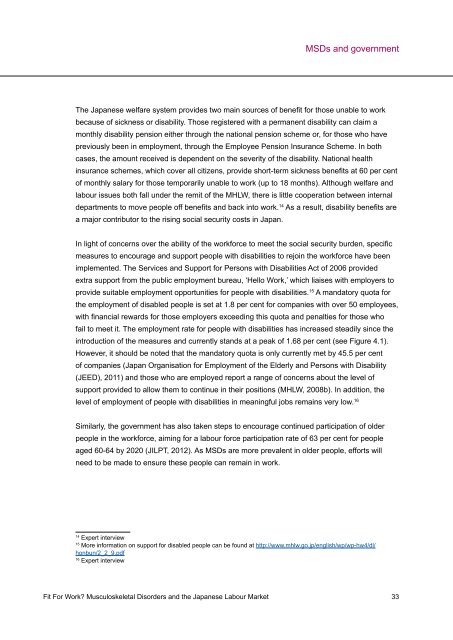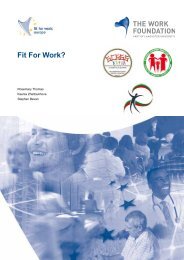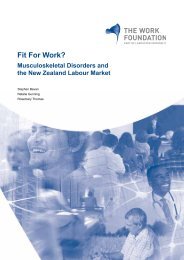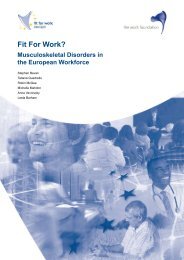English version - Fit for Work Europe
English version - Fit for Work Europe
English version - Fit for Work Europe
You also want an ePaper? Increase the reach of your titles
YUMPU automatically turns print PDFs into web optimized ePapers that Google loves.
MSDs and government<br />
The Japanese welfare system provides two main sources of benefit <strong>for</strong> those unable to work<br />
because of sickness or disability. Those registered with a permanent disability can claim a<br />
monthly disability pension either through the national pension scheme or, <strong>for</strong> those who have<br />
previously been in employment, through the Employee Pension Insurance Scheme. In both<br />
cases, the amount received is dependent on the severity of the disability. National health<br />
insurance schemes, which cover all citizens, provide short-term sickness benefits at 60 per cent<br />
of monthly salary <strong>for</strong> those temporarily unable to work (up to 18 months). Although welfare and<br />
labour issues both fall under the remit of the MHLW, there is little cooperation between internal<br />
departments to move people off benefits and back into work. 14 As a result, disability benefits are<br />
a major contributor to the rising social security costs in Japan.<br />
In light of concerns over the ability of the work<strong>for</strong>ce to meet the social security burden, specific<br />
measures to encourage and support people with disabilities to rejoin the work<strong>for</strong>ce have been<br />
implemented. The Services and Support <strong>for</strong> Persons with Disabilities Act of 2006 provided<br />
extra support from the public employment bureau, ‘Hello <strong>Work</strong>,’ which liaises with employers to<br />
provide suitable employment opportunities <strong>for</strong> people with disabilities. 15 A mandatory quota <strong>for</strong><br />
the employment of disabled people is set at 1.8 per cent <strong>for</strong> companies with over 50 employees,<br />
with financial rewards <strong>for</strong> those employers exceeding this quota and penalties <strong>for</strong> those who<br />
fail to meet it. The employment rate <strong>for</strong> people with disabilities has increased steadily since the<br />
introduction of the measures and currently stands at a peak of 1.68 per cent (see Figure 4.1).<br />
However, it should be noted that the mandatory quota is only currently met by 45.5 per cent<br />
of companies (Japan Organisation <strong>for</strong> Employment of the Elderly and Persons with Disability<br />
(JEED), 2011) and those who are employed report a range of concerns about the level of<br />
support provided to allow them to continue in their positions (MHLW, 2008b). In addition, the<br />
level of employment of people with disabilities in meaningful jobs remains very low. 16<br />
Similarly, the government has also taken steps to encourage continued participation of older<br />
people in the work<strong>for</strong>ce, aiming <strong>for</strong> a labour <strong>for</strong>ce participation rate of 63 per cent <strong>for</strong> people<br />
aged 60-64 by 2020 (JILPT, 2012). As MSDs are more prevalent in older people, ef<strong>for</strong>ts will<br />
need to be made to ensure these people can remain in work.<br />
14 Expert interview<br />
15 More in<strong>for</strong>mation on support <strong>for</strong> disabled people can be found at http://www.mhlw.go.jp/english/wp/wp-hw4/dl/<br />
honbun/2_2_9.pdf<br />
16 Expert interview<br />
<strong>Fit</strong> For <strong>Work</strong>? Musculoskeletal Disorders and the Japanese Labour Market 33







